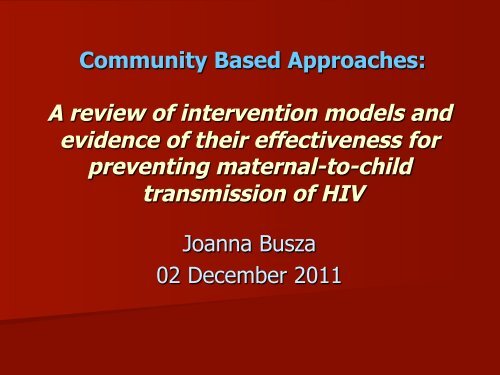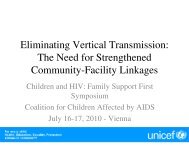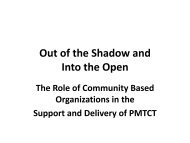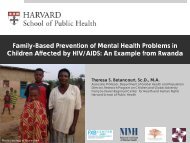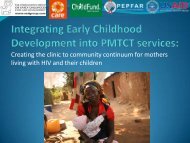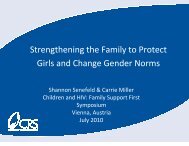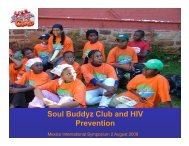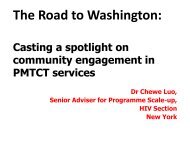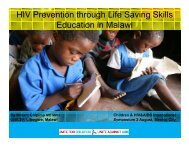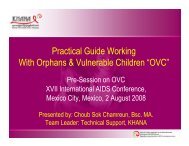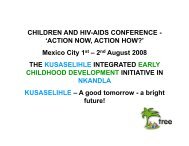A review of intervention models and evidence of their effectiveness ...
A review of intervention models and evidence of their effectiveness ...
A review of intervention models and evidence of their effectiveness ...
Create successful ePaper yourself
Turn your PDF publications into a flip-book with our unique Google optimized e-Paper software.
HIV Treatment CascadeAwareness Testing DiagnosisTreatmentinitiationAdherence& Follow-UpHealthOutcomes
SOCIAL ECOLOGICAL FRAMEWORK Social Welfare &InsuranceHealth BeliefsSocio-‐cultural Environment HealthPracticesLegal <strong>and</strong>PolicyStructuresReligionPerceivedCare QualityCommunity Context StigmaGenderNormsDistance toServicesPartnerInvolvementPeer & Family Influences Communication& DisclosureSocialNetworksAccess toResourcesIndividual SupportARV SupplySelf efficacyMotivationRisk PerceptionMental healthPhysical healthHealth Systems& Infrastructure
Partners, Peers & Family (1):n Community based & home testing• Increases opportunity to test• Introduces perception <strong>of</strong> risk• Engages family as a unit• House-to-House testing• Mobile clinics• Often accompanied by promotion activities inadvanceØ Improves HIV case finding BUT does not increase diagnosis<strong>of</strong> HIV+ pregnant women, who attend st<strong>and</strong>-alone clinics
Partners, Peers & Family (2):n Increasing male involvement• Targets communication, disclosure & decision-making• Based on association between women’s retention inprogrammes with her partner’s approval• Men invited to attend ANC or referred to testing sites• Couple counselling <strong>and</strong> breastfeeding advice provided• Accompanied by education sessions or support groupsØ “Male involvement” poorly defined <strong>and</strong> it is unclear how tocatalyse itØ Neviripine uptake higher among women whose partnershave been tested; unclear if this is a causal relationshipØ Other family members also important decision-makers
Partners, Peers & Family (3):n Peer Counselling• Reduces women’s isolation• Strengthens social support, especially from others whohave experienced similar challenges• Locally selected women trained in outreach <strong>and</strong>specific messages (breastfeeding, PMTCT, etc)• Home visits or counselling at facilitiesØ Some <strong>evidence</strong> <strong>of</strong> improvement to HIV+ women’spsychosocial healthØ No difference observed in Neviripine uptakeØ Effective in improving initiation, duration <strong>and</strong> exclusivity<strong>of</strong> breastfeeding
Community Context (1):n Formalised Links• Improves facility “friendliness” <strong>and</strong> support• Relies on peer volunteers or hired liaison staff• SMS message remindersn Home Based Care• Targets access to resources <strong>and</strong> food insecurity• Logistical & adherence support• Efforts to challenge stigma <strong>and</strong> reduce isolationØ Links improve relations with clients, but no <strong>evidence</strong> thatthey address wide range <strong>of</strong> barriers facedØ SMS reminders shown to improve drug adherenceØ HBC can improve adherence & follow-up, althoughsustainability an issue <strong>and</strong> HIV+ women <strong>of</strong>ten referred toHBC providers late (including after childbirth)
Community Context (2):n Community Health Workers• Work to change health beliefs <strong>and</strong> practices• Many different <strong>models</strong> have been evaluated• Applied to a wide range <strong>of</strong> health outcomes;increased popularity due to “task shifting” agendan Traditional Birth Attendants• Birth planning, attendance & referral• May be able to influence birth practices• Nevirapine provision• No outcome evaluations for PMTCTØ Long legacy <strong>of</strong> CHW success but operational factorsimportant given heterogeneity <strong>of</strong> implementationØ Feasibility studies & process evaluations suggest TBAcould be useful in settings with low facility deliveries
Socio-cultural environment (1):n Community Mobilisation• Complex <strong>intervention</strong>s – multiple components• Engage traditional leaders• Participatory, based on theories <strong>of</strong> empowerment <strong>and</strong>social action• Drama events, outreach, peer approaches, median Participatory Community Groups• Facilitated analysis <strong>and</strong> problem solving• Evidence drawn from maternal & neonatal health• Create supportive environments & support planningn Cash Transfers• Incentive for behaviour change• Provide a basic social safety net; address inequity
Socio-cultural environment (2):n Very difficult to evaluate community mobilisation,especially to differentiate relative <strong>effectiveness</strong> <strong>of</strong>componentsn Some <strong>evidence</strong> that mobilisation increases HCTuptake <strong>and</strong> adherence to ARTn Community groups have been rigorously evaluated<strong>of</strong> MCH <strong>and</strong> show promise for PMTCT given similardeterminantsn Cash transfers successful in Latin America inincreasing service use; transfer to poorer settingswith weaker health systems unclear
Ways Forward:n Contextualisation – applying the socialecological framework to identify barriers <strong>and</strong>design activities for each programme settingsn New approaches to scaling up <strong>and</strong> replication –transfer <strong>of</strong> process instead <strong>of</strong> contentn Long term commitment – resources <strong>and</strong> effortsneed to sustain community motivation; interimmeasures will change faster than outcomesn Stigma – critical barrier to social determinants <strong>of</strong>PMTCT <strong>and</strong> difficult to counteract
Thank you!Questions <strong>and</strong> comments?


